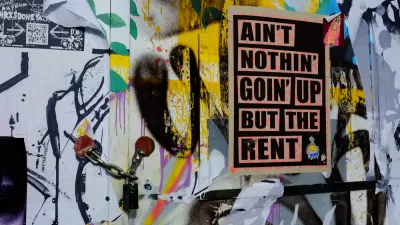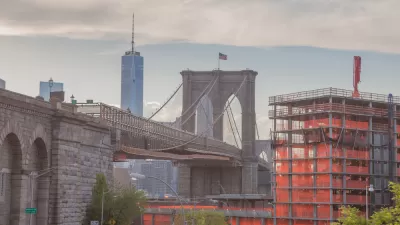A PBS NewsHour two-fer: an interview of urbanologist Richard Florida conducted in a walking tour of New York's famed High Line in the gentrifying West Chelsea neighborhood, a fitting backdrop for his new book, "The New Urban Crisis."

Economics correspondent Paul Solman interviews Richard Florida in this nine-minute report for the PBS NewsHour. Scenes along, below, and above the High Line are captivating and illustrative of the gentrification theme of Florida's new book, The New Urban Crisis. Both speakers share their knowledge of the rich history of West Chelsea and former rail line.
[Or click on the video "Has urban revival caused a crisis of success?"]
"Once they built the [High Line] park [in 2009], it became a draw, not of people, but for real estate developers," explains Florida. "And they never anticipated that. No one anticipated the High Line would be a place that luxury towers would grow up around."
If the old urban crisis was about the middle-class flight from the city to the suburbs, the new urban crisis is about really the disappearance of middle-class neighborhoods from our society.
Solman provides the context for Florida's new book, which is a successor to his first book, "The Rise of the Creative Class," published in 2002. "But what Florida now sees is the double edge of the advice he gave, and that so many followed." Florida explains:
A bigger, denser city in general increases the rate of innovation, increases the rate of start-up, increases the rate of productivity. At the same time, the bigger, the denser, the more knowledge-intensive increases the rate of inequality, increases the rate of economic segregation, makes housing less affordable. So it’s a two-sided monster.
Solman explains there are in fact two urban divides: one within cities between "the rich and the rest," and the interurban divide: "winner-take-all urbanism, the winners, San Francisco, New York, the losers, cities like Detroit, Milwaukee, Memphis."
Public transit
Can an efficient subway "close the gap," enabling workers less wealthy workers to live further away?
The video takes a detour to both ends of the #7 IRT subway, the Flushing terminal in Queens, and the first new subway station to open in New York since 1989, the Hudson Yards terminal at 34st Street.

The ultimate solution, though, rests with inclusionary zoning, asserts Florida.
If you want to build a tower like that [pointing to a high-rise], if you want to get the rights to create height and density, we’re going to make a trade. And the trade we’re going to make, in order for you to go up like that, you’re going to make affordable housing.=================
Related reading
- PBS: Column: ‘The New Urban Crisis’ is a crisis of capitalism, writ large," by Richard Florida, June 2, 2017
-
PBS: Making Sen$e: "Is the ‘creative class’ saving our cities, or making them impossible to live in?" by Paul Solman, June 1, 2017: Questions that weren't asked in the NewsHour segment above.
- Architectural Record: Book Review of "The New Urban Crisis" by James S. Russell, June 1, 2017.
- Planetizen: "As Cities Have Changed, So Have Richard Florida's Ideas", October 25, 2016: An early review of the ideas behind, including the genesis of, "The New Urban Crisis."
FULL STORY: Has urban revival caused a crisis of success?

Alabama: Trump Terminates Settlements for Black Communities Harmed By Raw Sewage
Trump deemed the landmark civil rights agreement “illegal DEI and environmental justice policy.”

Planetizen Federal Action Tracker
A weekly monitor of how Trump’s orders and actions are impacting planners and planning in America.

Why Should We Subsidize Public Transportation?
Many public transit agencies face financial stress due to rising costs, declining fare revenue, and declining subsidies. Transit advocates must provide a strong business case for increasing public transit funding.

Understanding Road Diets
An explainer from Momentum highlights the advantages of reducing vehicle lanes in favor of more bike, transit, and pedestrian infrastructure.

New California Law Regulates Warehouse Pollution
A new law tightens building and emissions regulations for large distribution warehouses to mitigate air pollution and traffic in surrounding communities.

Phoenix Announces Opening Date for Light Rail Extension
The South Central extension will connect South Phoenix to downtown and other major hubs starting on June 7.
Urban Design for Planners 1: Software Tools
This six-course series explores essential urban design concepts using open source software and equips planners with the tools they need to participate fully in the urban design process.
Planning for Universal Design
Learn the tools for implementing Universal Design in planning regulations.
Caltrans
Smith Gee Studio
Institute for Housing and Urban Development Studies (IHS)
City of Grandview
Harvard GSD Executive Education
Toledo-Lucas County Plan Commissions
Salt Lake City
NYU Wagner Graduate School of Public Service





























